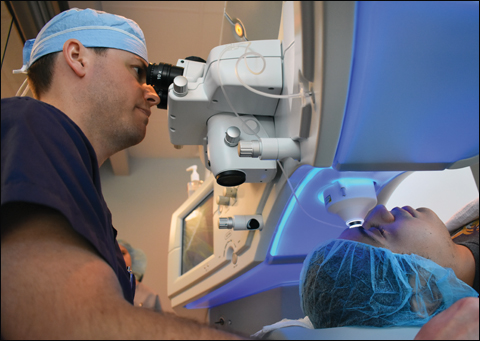PUBLICATION EXCLUSIVE: Overcoming the PRK mindset: Incorporating LASIK, SMILE into the military
The reason for undergoing refractive surgery as a member of the U.S. military is not necessarily a medical one.
For this population, wearing glasses in combat would encumber aiming systems, helmets and faceguards. In many cases, glasses and contacts are an unsafe option for soldiers deployed to harsh or combat environments, Gregory D. Parkhurst, MD, FACS, said.
“For that reason, refractive surgery is considered to be an important program for line officers and their troops, not only from the perspective of being more likely to accomplish their mission, but also in terms of their own personal safety,” Parkhurst said.
Parkhurst is president of the Refractive Surgery Alliance and served as an Army major until 2011, during which time he underwent PRK himself. He trained at Walter Reed Army Medical Center.

Image: Villarreal A
“When you’re in the military, you’re concerned with your personal safety, but also the safety of the soldiers around you. If your glasses get knocked off while you’re knocking down a door, not only are you putting yourself at risk, but potentially your compatriots as well. You have to do a specific job, so if you can’t see, you’re potentially putting your whole unit at risk in the heat of the battle.”
Within the Department of Defense, spectacle-free vision is seen as a means for preparing for battle, “not so much a medical need or medical condition,” Parkhurst said. As such, the DoD refractive surgery program is funded via a military warfighting budget that is separate from the department’s medical program, Parkhurst said.
PRK, LASIK, SMILE
The military approach to refractive surgery basically comes down to LASIK, PRK or SMILE, according to OSN Refractive Surgery Section Editor John P. Berdahl, MD. All three procedures provide visual acuity that meets DoD requirements. Parkhurst noted that phakic IOLs are also common in patients who are not candidates for laser vision correction.
PRK has a long track record of success as a vehicle for delivering spectacle-free vision for armed forces personnel who deploy into conditions where glasses or contact lenses would be a handicap. In 1995, PRK was the first vision correction surgery using a laser to be approved by the FDA; subsequently, it was also the first refractive surgery procedure allowed to be performed in members of the military when the DoD adopted laser refractive surgery in 2000.
- Click here to read the full publication exclusive, Cover Story, published in Ocular Surgery News U.S. Edition, July 10, 2017.
